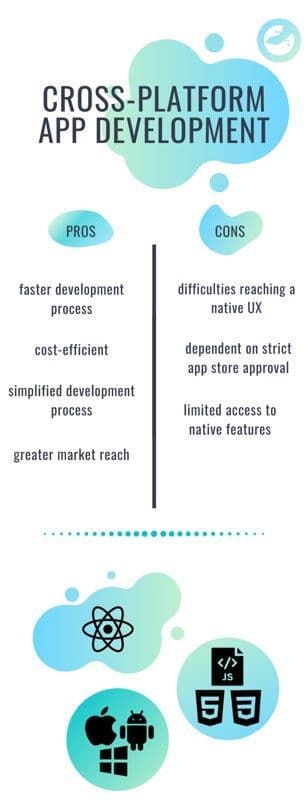app development
cross-platform development
+ 3 more ...
Understanding Cross-Platform App Development
01 Jul 2020
by Lotte, Digital Content Specialist
01 Jul 2020
by Lotte, Digital Content Specialist
app development
cross-platform development
devices
code
programming
Understanding Cross-Platform App Development
Table of contents
Contact us
We will get back to you in the next 48 hours.

Besides native mobile and progressive web app development, there is cross-platform development. Is cross-platform the best of both worlds?
During the past few weeks we’ve given you a deeper insight into the world of mobile app development and its different forms. In our detailed blog series you can read all you need to know about native app development and its platform-specific nature, or cost-effective progressive web app (PWA) development. This week we provide you with a deeper understanding of cross-platform applications, which possess the efficiency of PWAs, together with the quality and functionalities of native apps.
Understanding Cross-Platform App Development
Cross-platform app development seems like the ultimate solution for reaching the largest possible group of audience. Because not only will your app be accessible in app stores, it also allows the availability for multiple operating systems with just one codebase. Cross-platform applications are built with programming languages that are also used for web development, but possess the functionalities of a native app, as well as a performance that’s very close to the quality of native apps. Cross-platform development is great for JavaScript (React Native) or C# (Xamarin) writers who want to build native-like apps, but don’t want to dive into learning native app languages like Swift (iOS) and/or Java (Android). With one language, developers can access all platforms and operating systems, which, eventually, saves a lot of time and effort.
Cross-platform apps are generally developed in so-called app development frameworks, which come with all the tools and functions a developer needs to write clean code and build a well-functioning application. Let’s take a look at React Native, a popular framework for cross-platform development:
React Native
React Native is a framework tool for cross-platform development created by Facebook, and is currently one of the leading tools when it comes to cross-platform app development. React Native makes use of “React”, which is a Javascript library for writing front-end code. As you read in our blog about progressive web applications, JavaScript is a typical web app development language. Because JavaScript is a mature language, it has a broad range of documentation and open-source libraries for solving internal problems and bugs. This makes it an accessible language for developers to start with. React Native works as a bridge between JS code and native OS components, which gives it the qualities of both web applications and native applications.
React Native helps developers create apps that are close to native apps, with only one code base. The framework builds a hierarchy of User Interface (UI) components, and has a set of components for both iOS and Android to build a native-like app, but with backend of JavaScript code.

The pros and cons
Cross-platform applications bring along many benefits for both developers, customers, and end-users, and, therefore, seem like the perfect solution for app development. Whereas native app development generally requires a larger budget and more time and effort, cross-platform apps come close to the native experience, but are much more cost-effective and time-saving. However, like all other types of app development, cross-platform applications also come with their drawbacks. This emphasizes the importance of doing your research before you decide to have your app developed. Only when you know your target audience and the exact aims of your app, you can start looking at what type of app development fits your product best.
Pros:
Faster development process
The process of cross-platform app development is generally much faster than, for example, native app development. Cross-platform apps only need one code base, which can later be used for the deployment to other operating systems. Frameworks designed for cross-platform development possess tools that are especially made for facilitating the development process of these types of apps.
Cost-efficient
Because cross-platform development only requires one code base to work for multiple operating systems and devices, development costs are lower than, for example, native apps that need multiple different code bases in order to function on more than one operating system. However, Cross-platform development still requires some custom work that has to be done for iOS and Android-specific features.
Simplified development process
Cross-platform apps are usually very consistent in design and layout. This helps app developers build an app for different platforms with a similar look and feel, and supports a proper synchronization between the different mobile apps. This also counts for adjustments and updates within the app. With tools like PhoneGap and Appcelerator, mobile developers can easily fix bug fixes in the app and instantly deploy the changes to all the platforms the app is running on.
Greater market reach
Because cross-platform applications are built in such a way that the code is deployable for multiple platforms and devices, whether it’s Android or iOS, it reaches a far wider audience than native applications that are built for a single operating system, or progressive web apps that aren’t available in app stores. If your goal is to aim for a very broad target audience that isn’t necessarily bound to a specific platform or device, cross-platform development might be the best solution for you.

Cons:
Difficulties reaching the user experience of native quality
If cross-platform applications would possess the exact same quality and functionalities as native apps, it would have been the one and only way to develop mobile applications. But while cross-platform applications come close to the user experience of native apps, it’s still very difficult for developers to reach an equal level of quality and performance. Native cross-platform Software Development Kits (SDKs) are not mature yet and its graphical user interface needs to be repeatedly coded to achieve a platform-specific look and feel. Next to that, cross-platform applications do not have unlimited access to built-in native features.
Dependent on strict app store approval
In order for cross-platform applications to appear in app stores, they need to go through a very strict process of approval. Only if the cross-platform app meets all the requirements, it can be found and downloaded by users in the app store. Because native apps are built with platform-specific languages and toolsets, it usually fits the requirements of the app store immediately.
However, this is a much more complex process in the case of cross-platform apps, as they are built with a code that is not perfectly aligned with the native standards of a specific operating system. This makes the process of getting your cross-platform applications approved and available in the app store more time consuming than a native app, which could be an obstacle when you want to have your product on the market as soon as possible.
Some feature implementations require extra effort
Each platform and operating system has its unique and high-quality set of features and functionalities to make the user experience of native apps more cutting-edge. Because cross-platform applications are not built with a native codebase, it does not have the full access to platform-specific built-in features. However, some cross-platform frameworks allow developers to code certain features using native languages and bridge with React Native to create a complete solution. While this may require more time, and also knowledge in the native specific languages, it is still possible to almost achieve native's full capacity with a cross-platform solution.
Cross-Platform App Development at Lizard Global
At Lizard Global, our skilled and experienced team of developers make use of React Native for the execution of cross-platform app development. We have chosen react-native for the following reasons:
- It renders native UI components which creates a truly native user experience.
- It does not restrict to React APIs, but allows developers to write native code if and when required.
- It possesses a strong & big developer community supporting react-native. This means if a problem arises within react-native, or a certain new addition is required, it will be made available and or fixed within the community.
Do you want to know more about cross-platform software development, or are you wondering if it’s the right solution for you? Don’t hesitate to get in touch with us via our contact form or on our social media channels. Together we can figure out what type of app development fits your product and your needs best.

Besides native mobile and progressive web app development, there is cross-platform development. Is cross-platform the best of both worlds?
During the past few weeks we’ve given you a deeper insight into the world of mobile app development and its different forms. In our detailed blog series you can read all you need to know about native app development and its platform-specific nature, or cost-effective progressive web app (PWA) development. This week we provide you with a deeper understanding of cross-platform applications, which possess the efficiency of PWAs, together with the quality and functionalities of native apps.
Understanding Cross-Platform App Development
Cross-platform app development seems like the ultimate solution for reaching the largest possible group of audience. Because not only will your app be accessible in app stores, it also allows the availability for multiple operating systems with just one codebase. Cross-platform applications are built with programming languages that are also used for web development, but possess the functionalities of a native app, as well as a performance that’s very close to the quality of native apps. Cross-platform development is great for JavaScript (React Native) or C# (Xamarin) writers who want to build native-like apps, but don’t want to dive into learning native app languages like Swift (iOS) and/or Java (Android). With one language, developers can access all platforms and operating systems, which, eventually, saves a lot of time and effort.
Cross-platform apps are generally developed in so-called app development frameworks, which come with all the tools and functions a developer needs to write clean code and build a well-functioning application. Let’s take a look at React Native, a popular framework for cross-platform development:
React Native
React Native is a framework tool for cross-platform development created by Facebook, and is currently one of the leading tools when it comes to cross-platform app development. React Native makes use of “React”, which is a Javascript library for writing front-end code. As you read in our blog about progressive web applications, JavaScript is a typical web app development language. Because JavaScript is a mature language, it has a broad range of documentation and open-source libraries for solving internal problems and bugs. This makes it an accessible language for developers to start with. React Native works as a bridge between JS code and native OS components, which gives it the qualities of both web applications and native applications.
React Native helps developers create apps that are close to native apps, with only one code base. The framework builds a hierarchy of User Interface (UI) components, and has a set of components for both iOS and Android to build a native-like app, but with backend of JavaScript code.

The pros and cons
Cross-platform applications bring along many benefits for both developers, customers, and end-users, and, therefore, seem like the perfect solution for app development. Whereas native app development generally requires a larger budget and more time and effort, cross-platform apps come close to the native experience, but are much more cost-effective and time-saving. However, like all other types of app development, cross-platform applications also come with their drawbacks. This emphasizes the importance of doing your research before you decide to have your app developed. Only when you know your target audience and the exact aims of your app, you can start looking at what type of app development fits your product best.
Pros:
Faster development process
The process of cross-platform app development is generally much faster than, for example, native app development. Cross-platform apps only need one code base, which can later be used for the deployment to other operating systems. Frameworks designed for cross-platform development possess tools that are especially made for facilitating the development process of these types of apps.
Cost-efficient
Because cross-platform development only requires one code base to work for multiple operating systems and devices, development costs are lower than, for example, native apps that need multiple different code bases in order to function on more than one operating system. However, Cross-platform development still requires some custom work that has to be done for iOS and Android-specific features.
Simplified development process
Cross-platform apps are usually very consistent in design and layout. This helps app developers build an app for different platforms with a similar look and feel, and supports a proper synchronization between the different mobile apps. This also counts for adjustments and updates within the app. With tools like PhoneGap and Appcelerator, mobile developers can easily fix bug fixes in the app and instantly deploy the changes to all the platforms the app is running on.
Greater market reach
Because cross-platform applications are built in such a way that the code is deployable for multiple platforms and devices, whether it’s Android or iOS, it reaches a far wider audience than native applications that are built for a single operating system, or progressive web apps that aren’t available in app stores. If your goal is to aim for a very broad target audience that isn’t necessarily bound to a specific platform or device, cross-platform development might be the best solution for you.

Cons:
Difficulties reaching the user experience of native quality
If cross-platform applications would possess the exact same quality and functionalities as native apps, it would have been the one and only way to develop mobile applications. But while cross-platform applications come close to the user experience of native apps, it’s still very difficult for developers to reach an equal level of quality and performance. Native cross-platform Software Development Kits (SDKs) are not mature yet and its graphical user interface needs to be repeatedly coded to achieve a platform-specific look and feel. Next to that, cross-platform applications do not have unlimited access to built-in native features.
Dependent on strict app store approval
In order for cross-platform applications to appear in app stores, they need to go through a very strict process of approval. Only if the cross-platform app meets all the requirements, it can be found and downloaded by users in the app store. Because native apps are built with platform-specific languages and toolsets, it usually fits the requirements of the app store immediately.
However, this is a much more complex process in the case of cross-platform apps, as they are built with a code that is not perfectly aligned with the native standards of a specific operating system. This makes the process of getting your cross-platform applications approved and available in the app store more time consuming than a native app, which could be an obstacle when you want to have your product on the market as soon as possible.
Some feature implementations require extra effort
Each platform and operating system has its unique and high-quality set of features and functionalities to make the user experience of native apps more cutting-edge. Because cross-platform applications are not built with a native codebase, it does not have the full access to platform-specific built-in features. However, some cross-platform frameworks allow developers to code certain features using native languages and bridge with React Native to create a complete solution. While this may require more time, and also knowledge in the native specific languages, it is still possible to almost achieve native's full capacity with a cross-platform solution.
Cross-Platform App Development at Lizard Global
At Lizard Global, our skilled and experienced team of developers make use of React Native for the execution of cross-platform app development. We have chosen react-native for the following reasons:
- It renders native UI components which creates a truly native user experience.
- It does not restrict to React APIs, but allows developers to write native code if and when required.
- It possesses a strong & big developer community supporting react-native. This means if a problem arises within react-native, or a certain new addition is required, it will be made available and or fixed within the community.
Do you want to know more about cross-platform software development, or are you wondering if it’s the right solution for you? Don’t hesitate to get in touch with us via our contact form or on our social media channels. Together we can figure out what type of app development fits your product and your needs best.







